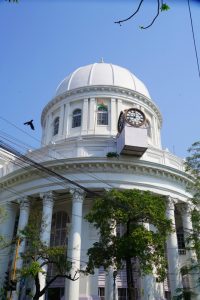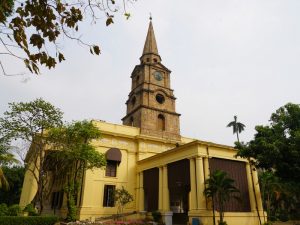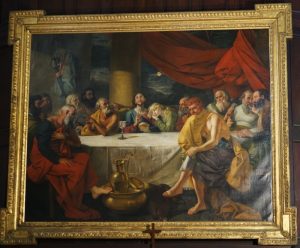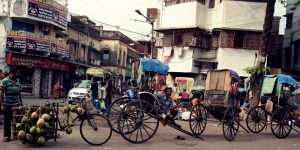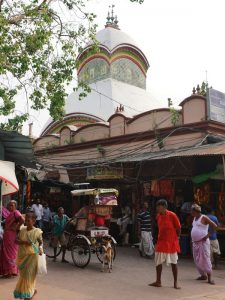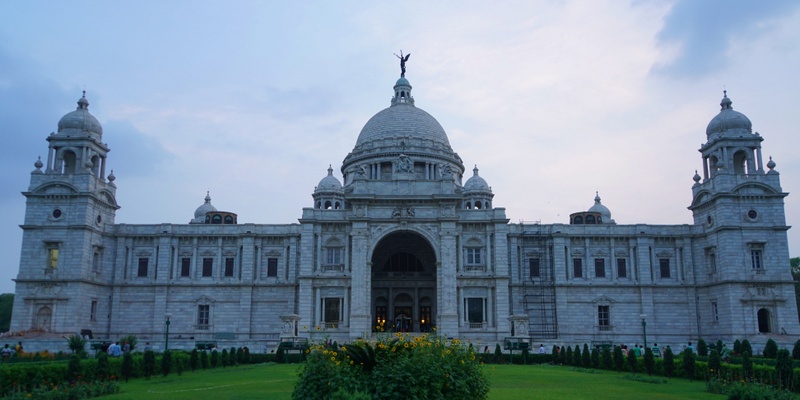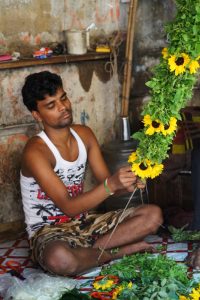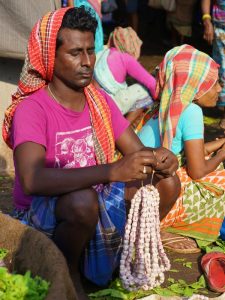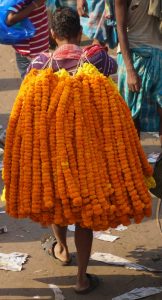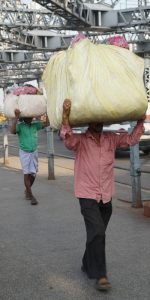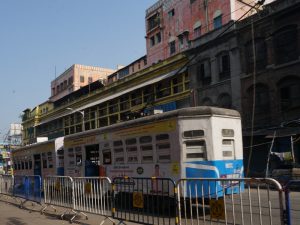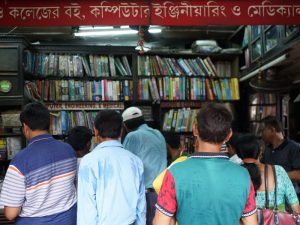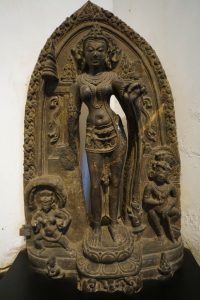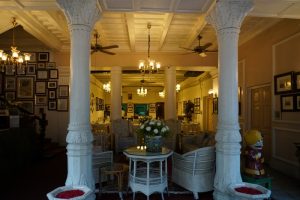April 4-6 Kolkata & Epilogue
Day 13 Friday: Dibrugarh, Assam – Kolkata, West Bengal by Air
Our flight would depart for Kolkata at 8 am. We left the hotel around 5:45 am and had to wait at the airport for a while for check-in. The Air India flight departed on time and we arrived in Kolkata before 10 am. The airport is fairly modern and a complete contrast to the one I first landed in Calcutta in the summer of 1978!
As the traffic was not bad, we arrived at Hotel Dee Empresa in an hour’s time. We had our rooms and Navin arranged a sightseeing tour for the group at 2 pm. I took Lesley to Blue Sky Café and we had lassi and marsala tea. I moved around like a local as I knew the area fairly well by now.
Kolkata, the third most populous city in India, has many incarnations. The British arrival in the 17th century had changed the fate of an obscure village on the banks of the Hooghly River: it evolved into the capital of Great Britain’s Indian empire until 1912. Today, Kolkata is the capital city of the state of West Bengal and the cultural capital of India.
The local guide began our city tour at the heart of Kolkata which is ringed with British colonial buildings dating to the 18th and early 19th centuries. In essence, they symbolised the imperial power over the subcontinent.
First, we stopped at St John’s Church, the first parish church established in 1787. The design was based on St Martin-in-the-Fields in London. It boasts an impressive painting of the Last Supper by Johann Zoffany who gave the 12 disciples the faces of British personalities famous in the city at the time.
The church is a living history book. We saw the armchair of Warren Hastings, Governor of Bengal. In the churchyard is a memorial to Lady Canning who died in 1861 and the mausoleum of Job Chamock who established a trading post in Kolkata in 1690 thus laying the foundation for the British Indian empire.
We also saw a memorial to the victims of the “Black Hole Tragedy”. When the Nawab of Bengal captured the old British fort which stood on the site of the present General Post Office (GPO) in 1756, he imprisoned over 100 British inhabitants in a small and airless cell. Only 23 people were alive the next morning.
Then we had a quick city tour and saw the white grandiose GPO built in 1860s, the imposing red brick Writers’ Building from 1777 with Corinthian façade, St Andres’ Kirk and the Government House (which is now the residence of the state governor) with Neo-Classical gateways. The guided pointed out the Maidan – a 400-ha park as we drove through the city.
Our guide then took us to Kali Temple which is Kolkata’s oldest pilgrimage site. As non-Hindu, I cannot enter the inner sanctum which contains an image of a wild untamed figure with tangled tresses and wide ferocious eyes. Her extended tongue has a gold covering which is changed every day.
Our third stop was Mother House, the headquarter of the Missionaries of Charity founded in 1950 by Mother Teresa (1910-1997), an Albanian nun who first landed in Calcutta on January 6, 1929. We visited the museum while a service was going on in the next room where her grave is placed.
We wished to pay respect but could not enter the hall owing to the ongoing service. Anyway, we saw her room with a bed, a writing desk and a wardrobe. It was the first time I came here: in 1978, I only visited The Home for the Dying near the Kali Temple where I met Mother Teresa at the back door when she came back from a village visit.
Our last stop was the Victoria Memorial, the city’s most celebrated landmark which took 16 years to complete (1905-1921). It was the brainchild of Lord Curzon, one of British India’s most flamboyant viceroys. It is now a museum with 25 galleries.
We only spent half an hour in the garden admiring the colossal building from the outside. There is a majestic bronze statue of Queen Victoria in front of the memorial.
It was getting dark. Navin took us to the Strand, the river front to enjoy the cool evening. We had a lovely stroll along the Hooghly River where we could see the lit-up Howrah Bridge and the new bridge. The area is lively with locals, tea and food stalls. I saw a family accompanied by a band arriving with an image of Kali and offerings in hand. They walked to the river bank and walked around in circle a few times. I loved to watch the rituals. But as I had to join the group and leave, I had to go. I wonder whether the image would be burnt or thrown into the river at the end of the ceremony.
It was after 7 pm when we returned to the hotel. As the tour would end the following day, the whole group went out for a farewell dinner. It was raining heavily. Luckily the BBQ restaurant is not far. We arrived without getting too wet. I had turf and surf for around R550. It is cheap but the Indian style of cooking has not brought out the best of the prawn and beef. I found the meat overcooked, too salty and saucy. Anyway, we enjoyed the trip and have seen a very different part of India.
Day 14 Saturday: Kolkata (End of Tour)
There was no group activity. All except Laurelyn and Lesley would be going to the airport in the late afternoon or late evening, we practically a morning or in my case a full day in Kolkata. Navin suggested us visit the flower market by the Howrah Bridge.
Seven of us met at the lobby at 6:30 am and travelled in two taxis. I shared one with Janet and Leslie. The traffic came to a halt when we were five minutes’ drive from the market. We therefore got off and walked. It is an eye-opening experience!
The traffic was chaotic and grinded to a halt. On the side of the street are stalls, street sleepers and garbage. The whole area is derelict and dirty. After walking for about 10 minutes, we arrived at a pedestrian bridge leading to the flower market. Many were heading to the market while many were leaving with flowers in their hand or shoulder. The whole area was lively and exploded with energy: noises came from all directions, colours and scents of flowers and quick movements made one dizzy.
I ran into Lesley and we walked together. We walked up and found a vantage point to look at the market below for half an hour. Then we took a short walk along the famed Howrah Bridge. I thought I had travelled through a time tunnel: old buses were running along the bridge and some locals were carrying enormous loads on their head or on a bicycle. Some had loads of flowers and were on the way to sell them. A few were struggling to push their heavy cart.
Next, we walked to the river bank opposite the Howrah Railway station. We watched locals bathing in the river and fishing boats passing by.
As the market is close to the centre of the city, Lesley and I took this opportunity to explore the old Kolkata on foot. The area around the bridge is more crowded, dirtier and noisier now than in 1978. I looked sadly at the overcrowded and derelict buildings. I saw only men: some were bathing and washing at the water stand, many were apparently seeking odd jobs, some were preparing tea and food at the street stalls.
We walked past the Writers’ Building. But the security guards stopped us from taking photos even from the outside. We stopped at the GPO and looked through the gate where the “Black Hole Tragedy” took place. When we reached the Royal Insurance Building opposite the GPO, we decided it was time to return to the hotel for breakfast.
We arrived at the hotel after 9:30 am. In the restaurant, we met Susan, Claire and Jeff. I got up so early that I felt tired after the exhausting morning walk. I went back to sleep till noon. Lesley left and moved to another heritage hotel nearby for a night before flying back to Glasgow.
After checking out of the hotel, I went to the College Street to look for a book for Brenda. Once again, it was a most unforgettable experience: I have never seen so many small book stalls/stands most of which are selling books for schools and examinations. I watched Indian students and their parents yelling and fighting for attention of the stall keepers in a few bigger book shops. The deafening noises and thongs of people are unbelievable.
I saw a tramway and decided to take a ride. I literally ran after a tram and jumped onto it! I found a seat and paid R6 for a ride. The glass window was filthy and half covered with coloured paper. It is therefore difficult to see the outside world from the tram. I am glad that trams in Hong Kong are much better maintained and comfortable!
I intended to have a cup of tea at the Oberio Grand Kolkata. I walked in this famed luxurious hotel after wading through countless street stalls selling cheap clothes and other stuff outside the hotel. But the coffee shop does not appeal to me. So, I left and continued my walk to the Indian Museum.
I spent two hours in the Museum. The sculpture collections on Buddha, Hindu gods and goddesses are outstanding. There is a gallery on sculpture from Gandhara. But I was moved as well as shocked when I saw the sculpted railings from the 2000 year-old Bharhut Stupa. I must have spent over 15 minutes looking at each railing. It is so well preserved and perfectly sculpted. I must go to see this archaeological site on my next visit to India.
I was emotionally and physically exhausted by now. I went to the Elgin Fairlawn Hotel which is highly recommended by Lesley. It has old charm and atmosphere. I sat down and had a fresh lime soda as I was very thirsty. I had thai noodles at the Blue Sky Café before spending a few hours at the lobby of the Hotel Dee Empresa. Shortly after 9 pm, I began to call for a taxi. As it had been raining heavily the whole evening, I had difficulties to find a taxi for half an hour. I got a anxious. Finally I got a shared taxi for R450 and managed to arrive at the airport around 11 pm. I checked in and the plane departed on time shortly after 1 am. I was so tired that I slept the whole way back to Hong Kong despite the uncomfortable middle seat. I landed in Hong Kong before 8 am on April 7.
Remarks (written and uploaded on May 17, 2020)
India is fascinating and is one of my favourite countries. On my eighth trip to India (February 27 to April 6, 2019), I joined two different tours, namely Southern India and East Coast by Rail and Assam (Aoleang Festival) and travelled independently for ten days in Darjeeling and Assam. I ended up spending 39 days in seven states namely Kerala, Tamil Nadu, Telangana, Odisha, West Bengal, Assam, Meghalaya and Nagaland.
When writing this ‘Remarks’ section, I can’t believe I had made this journey roughly a year before the Covid-19 pandemic. Memories are still fresh and I try to recap my amazing experiences in three parts.
Southern India and East Coast by Rail (March 1 – 14, 2019)
I have travelled with G-Adventure several times and enjoy its backpacking travel style. This time, we had a small group of six and I met two nice new friends, Carla (my roommate) and Mike.
First, I visited 11 cities/towns in five states namely Kochi, Alleppey and Kanyakumari in Kerala, Madurai, Mamallapuram, Auroville, Puducherry and Chennai in Tamil Nadu, Hyderabad in Telangana and Puri in Odisha and Kolkata in West Bengal. I reached the southernmost tip of India when taking a ferry to the holy Vivekananda Rock in Kanyakumari.
Second, I have travelled like the locals. On this tour, we spent some 45 hours on six trains (i.e. six hours on two local trains, five hours on the Kanyakumari Express to Madurai, five and a half hours on the Vaigai Express to Chengalpattu, 12 hours overnight on the Chennai – Hyderabad Express and seven hours on the Shatabdi Express to Kolkata). The Indian trains are still decades behind those in China.
Tuk-tuk is the normal mode of transportation in town. On one occasion, we had to curl up for almost an hour in a tuk-tuk travelling for some 20km. Occasionally, the guide arranged a minibus or a taxi for long ride in town and between towns. As local trains are slow, dirty and often late, I think travelling by road from Kochi to Chennai might be more efficient and a better option.
Third, we normally stayed in basic local hotels. I have no problem as long as the place is clean and the bed is bug-free. I was even able to sleep in my own clean sleeping bag on an overnight train.
Fourth, the itinerary has met my expectations. Apart from Kochi, Alleppey and Kolkata, all the places are new to me. Southern India is different from the north. I particularly like Auroville (a unique futuristic city and spiritual centre), Puducherry (former capital of French territories in India) and Hyderabad. I love to return to Tamil Nadu and Telangana again.
As for specific attractions and locations, I am impressed by the amazing and exquisite architectures and beauty of the Meenakshi Amman Temple in Madurai, the Shore Temple, Arjuna’s Penance and Pancha Rathas in Mamallapuram, the Golconda Fort and Qutb Shahi Heritage Park in Hyderabad, Konark Temple and Jagannath Temple in Puri, and the Sundarbans National Park (the world’s largest tropical mangroves) in West Bengal. Some of these are World Heritage Properties.
Finally, I was glad to return to Kochi where the tour began. I was therefore able to visit the Kochi-Muziris Biennale 2018. Some of the installations are impressive.
Darjeeling, West Bengal & Guwahati, Assam March 14 – 23
Darjeeling
I made my way to Darjeeling and Assam by train. The Shatabdi Express took nine hours to travel from Kolkata to Siliguri covering some 560 km. This train is surprisingly modern, clean and comfortable by Indian standards. From Siliguri, I took a minibus to Darjeeling like a local. I did think of taking the train all the way to Darjeeling. But I failed to get a ticket in Mamallapuram. I was flexible and was hoping to make a side trip to Sikkim. But as a Chinese though travelling with a HKSAR passport, I could not get a permit. As a result, I spent two days in Darjeeling and three days hiking in the Singalila National Park (March 17-19).
As a whole, I had a leisure time in Darjeeling. I stayed at the Vajar Kunj Homestay which is simple, cosy and super clean. Bobby the owner and his family make me feel at home. I love the home cooking.
But my romantic views of this hill station have been shattered. The Chowrasta, Observatory Hill and the Mall are messy and over-developed. Pressure of growing population has led to illegal construction of houses along the road and on steep slopes. The narrow winding roads are congested and dirty. I doubt whether there is proper drainage and clean water supply. Pollution must be a problem. A ride on the nostalgic DHR steam train is said to be a ‘must’. I paid R1,405 for a ride at 4 pm to Ghum. The weather was so-so without sunset. What upset me most was the sight of black smoke from coal burning from the train.
The best time I had in Darjeeling was on the hike. I walked less than 35 km over three days. The landscape is average by my standard. But the Shikhar Lodge where I stayed two nights, serves excellent food and the Nepalese are fantastic. I watched sunrise and saw a romantic pinkish Kanchenjunga.
I learn that one can reach Sandakphu, the highest point in Bengal at 3,636m, by road. From this peak, one can see four of the world’s five highest peaks – Everest, Kanchenjunga, Makalu and Lhotse – in a continuous snow-clad arc. I hope to return before I die to spend a few nights in December at Sandakphu to see these 8000+ peaks at sunrise.
Guwahati & Manas National Park, Assam (March 20 – 23)
After Darjeeling, I took the minibus back to Siliguri and caught the train to Guwahati. This was my nineth train journey. I spent some six hours covering 472km. The train was old and filthy. I noticed most of the passengers were men. It was quite an experience.
I was in Guwahati during the Holi Festival (also known as the Festival of Colours) which is adored by visitors for fun and colours. But I bluntly told the locals not to throw the powder at me. I was too late: on one occasion, the kids threw powders that got into my camera. I had a scary time to clean up the lens.
I like Guwahati which is also called ‘City of Temples’. I visited three important temples. Kamakhya Temple, a complex with unique architectures, was atmospheric and crowded with pilgrims. The Navagraha Temple enshrining nine celestial bodies is also a research centre of astrology and astronomy. The small Umananda Temple located on the top of the tiny Peacock Island in the middle of the Brahmaputra River is iconic.
My trip to Manas National Park was uneventful. As I could not book an elephant ride, I took a jeep by myself for four hours. I was at the border stone of India and Bhutan and by the Manas River. As expected, I did not find any tiger and saw only elephant, golden langur, deer and peacock. I took my last and tenth train ride back to Guwahati.
Assam, Meghalaya and Nagaland Explorer March 24 – April 6
I joined Exodus’s first group to visit Assam, Meghalaya and Nagaland at the time of the Aoleang Festival in Mon. We had a group of 15 with Navin as our guide.
This tour offered a totally different travel experience as compared to the trip with G-Adventure. First of all, it was not a backpacker group: we stayed in comfortable hotels and eco resorts and had nice food. We travelled by road in two 11-seater vans. Though the roads are paved and not bad by Indian standards, they are winding and often only two-laned. As a result, though we spent a fair amount of time on the road covering over 1,100km, we still had time for a lot of activities.
The topography, landscape, climate, vegetation and people are totally different. The whole region is hilly, green, rural and less populated. Assam is also the largest tea production state in India.
This tour far exceeds my expectations. First, it has taken me to the off-the-beaten tracks in India, a region I always want to explore.
Second, we had leisure time in the countryside with only a night in Guwahati, Shillong, Sivasagar, Dibrugarh and Kolkata.
Third, the tour was designed in such a way that we had two nights in Cherrapunjee, La Vue Resort near the Kaziranga National Park, Majuli Island and Mon. I enjoyed the strenuous hike to see a 150-year-old double-decker living root bridge. In the Kaziranga National Park, I saw countless rhinos.
The Majuli Island the largest river island in the world, is a highlight. We have travelled like the locals and crossed the Brahmaputra River in a local ferry. The eco resort is rustic without electricity but its food is excellent. We met shy but friendly villagers and visited three sas (temple) which are much smaller. These temples are clean, interesting and more intimate. I particularly like Uttar Kamalabari Satra that only keeps two copies of the Gita and has no idol or image and Auniati Satra has an image of Lord Krishna, its idol, that was brought from Jagannath Temple in Puri.
The best part of the trip was our time in Nagaland. This hilly and remote region is awesome with most beautiful landscape. I enjoy our visit to the Hongphoi Village where we met the headhunting tribe and the Longwa Village located at the India-Myanmar border. We spent an afternoon watching men taking part in competitions and a whole morning watching a procession and a performance of the Aoleang Festival in the stadium.
Their traditional attire is most colourful, their music and dance are fascinating and spectacular. It was a pity we had to leave on April 4 and missed the spectacular show with some 4,000 Konyak ladies dancing to a ceremonial song for five minutes on April 5. Had it not been for the pandemic this year, more tourists would have gone for this festival this year bringing much-needed tourism revenue to this poor part of India.
Our trip ended again in Kolkata which I first visited in 1978 on a study trip. This time, the guided tour arranged by Exodus took me for the first time to St John’s Church, the Kali Temple, the House of Mother Teresa and the Strand with a stroll along the Hooghly River. On my last day, I went to the famous flower market by the Howrah Bridge before 7 am. It is a ‘must’ for visitors and a mind-blowing experience. The colours, the crowd, the setting, the noise and energy are mesmerising. I stood on the Howrah Bridge, walked along the Hooghly River next to the flower market and watched the locals bathing in the river and boats sailing by. I could feel the pulse and rhythm, the spirit and life of the city.
Somehow, Kolkata is one of the few places that can stir me up. When strolling in old Kolkata, I recognised some of the buildings I saw in 1978. They look dilapidated, more crowded and worse than the condition some 40 years ago. The flower market is filthy and covered with garbage. The pedestrian bridge over the railway line and the railway line look as though it had not been cleaned since the departure of the British.
Despite the chaos and dilapidation, Kolkata with its rich colonial history and as a melting pot of cultures and communities, is vibrant and humane. Old Kolkata is studded with majestic historical buildings and the Indian Museum is a gem. My walk in the College Street with hundreds of book stalls and thousands of students queuing up to buy school books and a ride on the old tram are two other mind-blowing experiences.
To conclude, my 39-day travel from the south to the northeast of India sub-continent covering some 2,000km by rail and 1,500km by the road, is an eye-opening experience. I had a great time whether travelling alone or with a group. Of course, it is often fun to travel with like-minded mates. Lesley, who loves travel, has given me tips on trips to Yemen, Libya and Djibouti. These are places I love to visit one day.
India rich in history, culture and natural assets has 38 World Heritage Sites. Out of its 28 states, I have only visited 16. Certainly, I shall return again with a view to visiting the remaining 12 states and 11 World Heritage sites.




